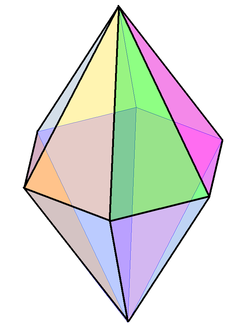- Hexagonal bipyramid
-
Hexagonal bipyramid 
Type bipyramid Faces 12 triangles Edges 18 Vertices 8 Face configuration V4.4.6 Symmetry group D6h, [6,2], (*226) Dual hexagonal prism Properties convex, face-transitive A hexagonal bipyramid is a polyhedron formed from two hexagonal pyramids joined at their bases. The resulting solid has 12 triangular faces, 8 vertices and 18 edges. The 12 faces are identical isosceles triangles.
It is one of an infinite set of bipyramids. Having twelve faces, it is a type of dodecahedron, although that name is usually associated with the regular polyhedral form with pentagonal faces. The term dodecadeltahedron is sometimes used to distinguish the bipyramid from the Platonic solid.
The hexagonal bipyramid has a plane of symmetry (which is horizontal in the figure to the right) where the bases of the two pyramids are joined. This plane is a regular hexagon. There are also six planes of symmetry crossing through the two apices. These planes are rhombic and lie at 30° angles to each other, perpendicular to the horizontal plane.
See also
- hexagonal trapezohedron A similar 12-sided polyhedron with a twist and kite faces.
- Snub disphenoid Another 12-sided polyhedron with 2-fold symmetry and only triangular faces.
External links
- Weisstein, Eric W., "Dipyramid" from MathWorld.
- Olshevsky, George, Bipyramid at Glossary for Hyperspace.
- Virtual Reality Polyhedra The Encyclopedia of Polyhedra
- VRML model hexagonal dipyramid

This polyhedron-related article is a stub. You can help Wikipedia by expanding it.
